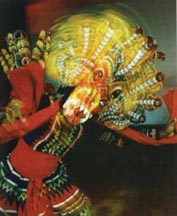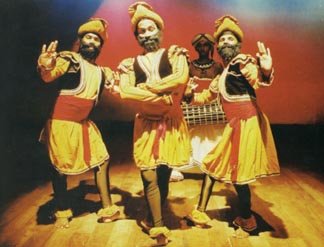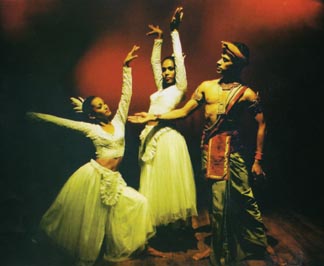|
observer |
|
|
|
|
|
OTHER LINKS |

|

|

|
A Fusion of Dance TechniquesThe Ruhunu Ballet from the south of Sri Lanka focuses on the fusion of contemporary dance techniques with the traditional.
With members descending from generations of dancers from the Southern Province, the troupe is determined to preserve a rich legacy while blending different forms of dance to create a distinctive style. This is a combination of classical Russian and Sri Lankan ballet. The troupe focuses on typical southern dance forms - Ruhunu dancing - which is ritualistic and originates from pre-Buddhist folk religion and traditions. It is renowned for the use of oversized colourful masks. It is believed that masks propitiate the gods to cure illness caused by demons. Another form of Ruhunu dancing is Kolam dancing - folk theatre. The troupe adopts six styles of Kolam dancing in addition to other forms of low country dancing. These include Gini Sisila - fire eating and ritual, Thelme - dance in honour of goddess pattini, and Naga Gurula - dance depicting a fight of the cobra and eagle.
Deviating from the Kandyan Vannam tradition, the troupe has pioneered a new style by introducing improvised movements, a combination of Kandyan dancing and ballet. These extemporized movements have created a distinctive style, which is fluid, airy and whimsical. The thuranga (horse), mayura (peacock), nai adhi (cobra), kirala (red-wattled lapwing), ukusa (eagle) and gajaga (elephant) are some of the animals that have been depicted in this dance form.
The Ruhunu Ballet had the rare privilege of performing the Lanka Sri Ballet at the 50th Independence Day Celebrations of Sri Lanka, which was attended by Prince Charles. An overseas tour by Ruhunu Ballet is planned. The patron of Ruhunu Ballet is architect, Navin Gunaratne. He has been involved in obtaining international exposure for the troupe. The Ruhunu Ballet has toured Sweden, Norway, Germany, Russia, Korea, Thailand, Japan and India. These tours were sponsored by CIOFF - International Council for Organisation for Folklore Festivals and Folk Art, an affiliated organisation of the UNESCO. Another artist who supports the troupe is Senaka de Silva, Sri Lanka's famous dress designer and choreographer. De Silva adds invaluable input to the dancing styles of the troupe in addition to designing their costumes in line with the modern trends. Explore SL 2005 |

 Ruhunu Ballet was formed in 1997 under the state patronage of the
Southern Development Authority. Today, registered under the Cultural
Secretariat in Sri Lanka, the troupe comprises 22 enthusiastic dancers
(14 boys and eight girls) under the leadership of Siriwardena Bandara
who has been associated with the troupe since its inception.
Ruhunu Ballet was formed in 1997 under the state patronage of the
Southern Development Authority. Today, registered under the Cultural
Secretariat in Sri Lanka, the troupe comprises 22 enthusiastic dancers
(14 boys and eight girls) under the leadership of Siriwardena Bandara
who has been associated with the troupe since its inception. 
 The Ruhunu Ballet has provided an interesting variation to the
Kandyan dancing for Vannam tradition. The word Vannam is derived from
the Sinhalese word varnana, which means descriptive phrase. The
traditional Vannam has been recreated by music genius Mahesh Denipitiya.
The Ruhunu Ballet has provided an interesting variation to the
Kandyan dancing for Vannam tradition. The word Vannam is derived from
the Sinhalese word varnana, which means descriptive phrase. The
traditional Vannam has been recreated by music genius Mahesh Denipitiya.
 In their performances at hotels, the troupe puts together theatrical
dances done to a choreographed story line. These encompass a range of
Sri Lankan dancing, adding diversity through a variety of music, styles,
steps and costumes. Both locals and tourists enjoy these performances.
In their performances at hotels, the troupe puts together theatrical
dances done to a choreographed story line. These encompass a range of
Sri Lankan dancing, adding diversity through a variety of music, styles,
steps and costumes. Both locals and tourists enjoy these performances.








